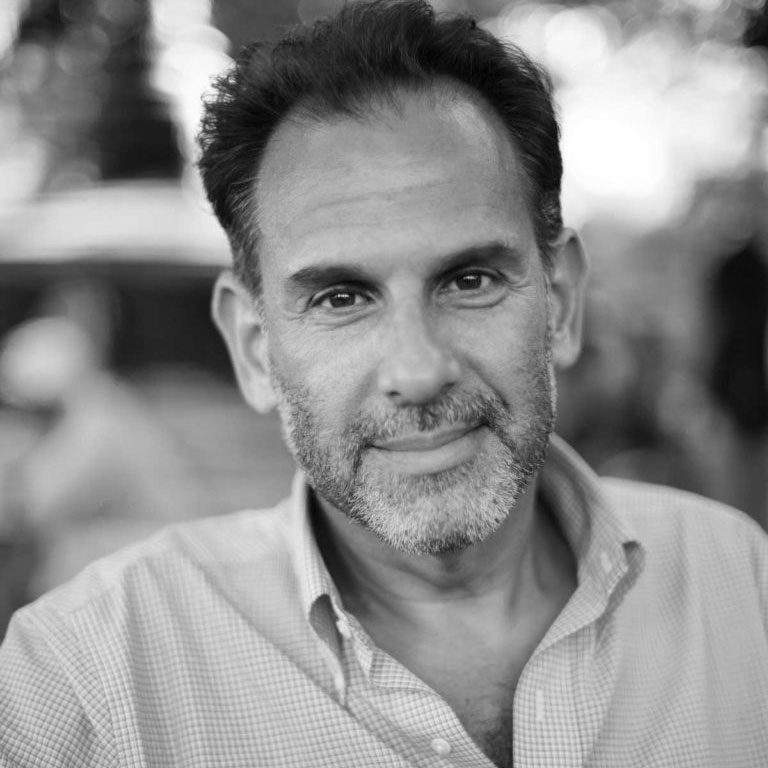Bobby Flay’s Forgotten Sherman Oaks Origin Story, An Opera Restaurant in LA, Taxicab Confidential, and Other Moments That Deserve a Home
Hi, everybody. Here’s what I think will be a fun recurring feature: As publishing date for Chefs, Drugs,and Rock & Roll–my book about the American chefs of the 1970s and 1980s–approaches (it’s now available for preorder), I am going to be sharing some stories that are amusing and/or interesting, but that I couldn’t find room for in the book without slowing down the narrative, or exceeding my allotted word count. I’ll do this periodically for the foreseeable future, until the gems run out. To kick things off, here are some of the cuts that hurt the most:
Bobby’s Flay’s Excellent Adventure
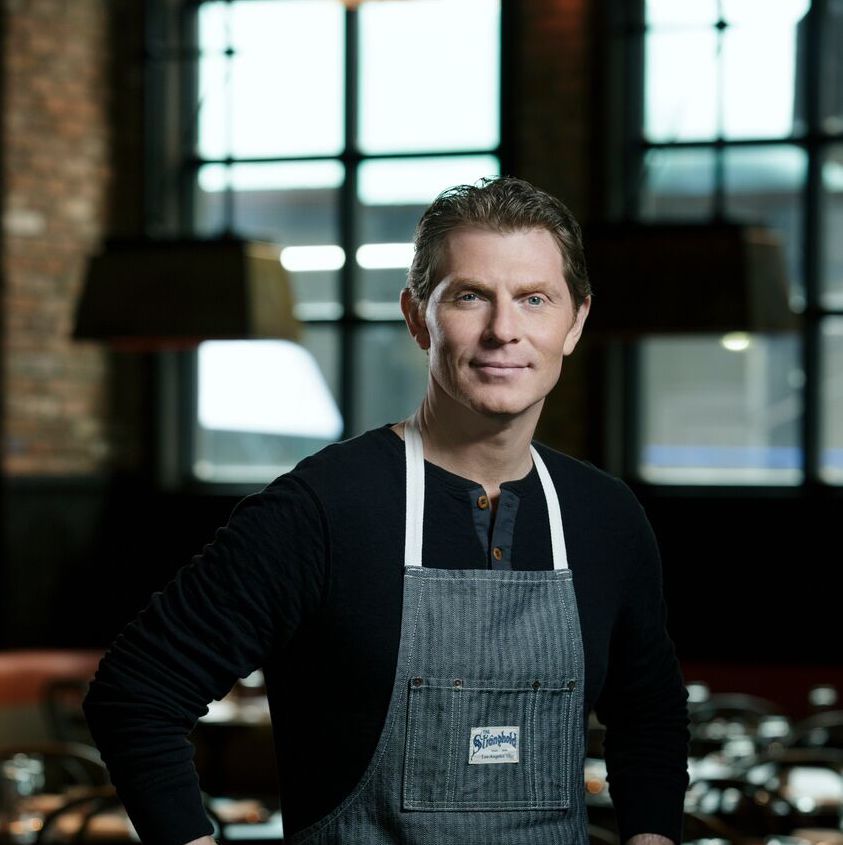
Bobby Flay … (photo copyright Bobby Flay)
The year was (probably) 1987. A young cook named Bobby Flay had graduated the French Culinary Institute, honchoed his own kitchen (before he was really ready for it), worked for Jonathan Waxman at Bud’s, which had a Southwestern bent, and other restaurants the red-hot chef co-owned with partner Melvyn Master. Bobby was on the launchpad to success at a time when the profession was rocketing to another place. But he’d been working for almost eight years and was burnt out and sick of making a cook’s wage when a lot of kids from the old neighborhood (in his case, the Upper East Side) were raking in New York money on Wall Street, buying their first apartments. He shelved his knives and took an entry-level job “in the wires” of the (now defunct) American Stock Exchange. But he found the non-creative, cutthroat environment soul-crushing, and noted with horror that every man in sight had lost his hair. The same connection who set him up in the financial world called him with an opportunity to get back in the kitchen, as chef of a new restaurant … in Sherman Oaks, California.
Bobby was torn. He wanted back into the restaurant world, but was a New Yorker to the core. From a phone booth in the basement of the Stock Exchange, he made the Golden State restaurateur a preposterous offer: “I want fifty-thousand dollars a year; I want 10 or 15 percent of the profits; and I want a company car–a Honda Accord.” Bobby laughs when he tells this next part: “He goes ‘done,’ and I fucking move to California. Nobody knew who I was.”
The restaurant was Turquoise Cafe, a Southwestern bistro on Ventura Boulevard. Though virtually un-Google-able today, it was reviewed in the LA Times by a witty young writer then going by J.D. Gold. Bobby is not mentioned by name, but the review is a fascinating glimpse of the young chef finding his voice.
The gig only lasted about a year. When Bobby got back to Manhattan, he quickly morphed into the Bobby of national fame: After a brief stint at Trixie’s, a quirky Times Square restaurant and bar (I think it’s the first place I ever had sweet potato fries), he convinced the owners of a new East Village restaurant, Miracle Grill, that they should veer away from the Mexican place they had in mind, and go Southwestern: “There’s a new movement here,” he told them. “It’s a movement of Mexican ingredients, but it’s a Southwestern version: It’s healthier, it’s prettier, it’s vibrant, and tequila goes really well with it.” [Editor’s note: tequila sales = mucho dinero.] He cooked the owners an audition menu–the only dish he remembers today is pork with sage vinaigrette–and landed the gig. And Miracle Grill is where restaurateur Jerry Kretchmer, flying high with success at Gotham Bar and Grill, and in love with the Southwest from family vacations, discovered him, starting the steps that would lead to Mesa Grill and Bobby’s rise.
A Chance Encounter
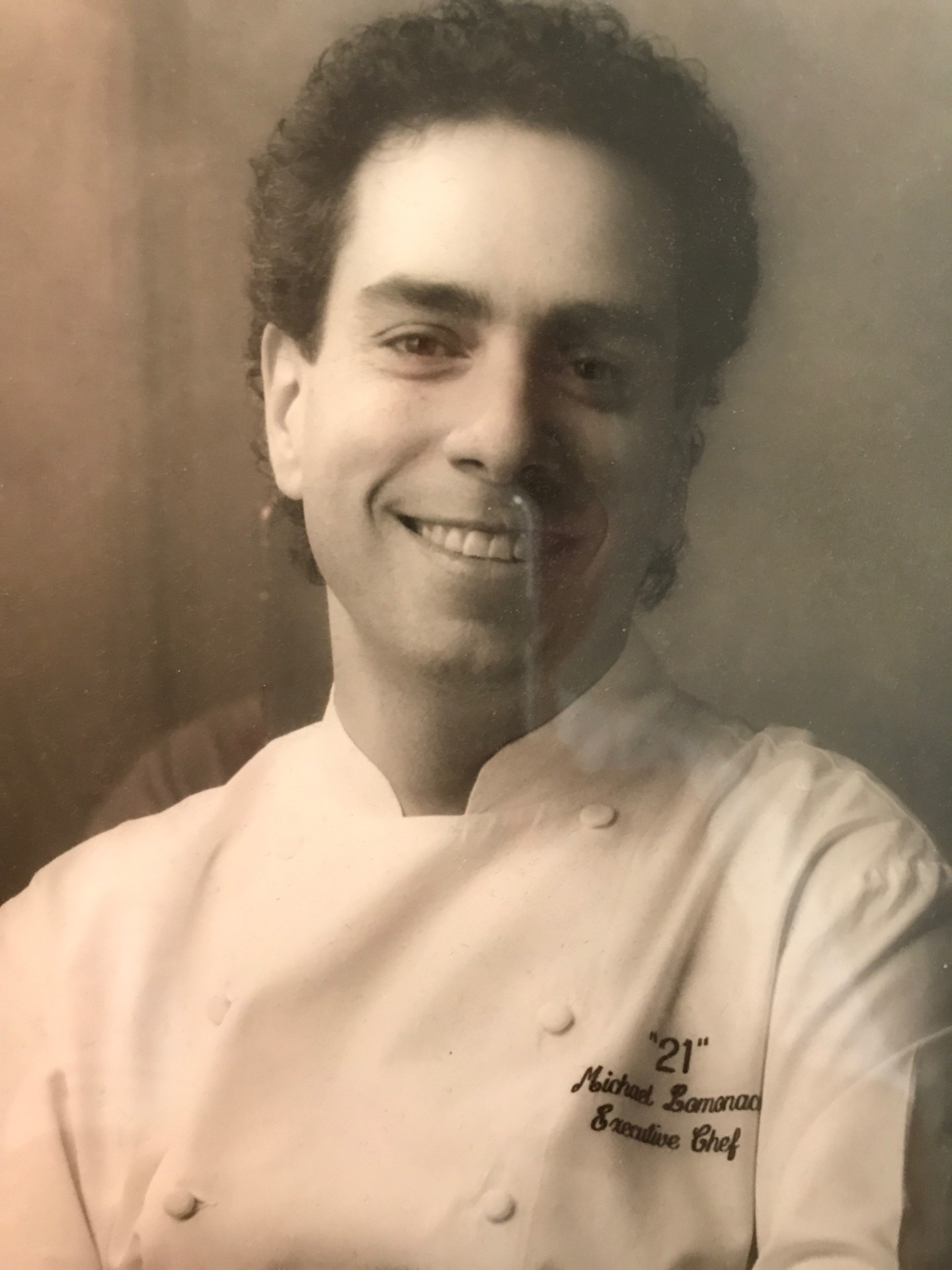
Michael Lomonaco, in his ’21’ Club days … (photo copyright Michael Lomonaco)
In the early 1980s, Porter House Bar and Grill‘s Michael Lomonaco was an actor in New York City. (Pay close attention and you might spot him in a non-speaking role in Broadway Danny Rose.) He had other outlets for his creative leanings, like music, but he wasn’t yet thinking of cooking in that way. Michael drove a taxi back then, and one night, he picked up Patrick Clark. Here’s an edited snippet of Michael’s remembrance about this fateful meet-up with the late, great chef:
“I knew who he was and I recognized him. Of course I knew who he was because his photos were appearing in New York Magazine, the New York Times. I picked him up at the Odeon at 1:00 in the morning, and I told him I knew who he was as soon as he got in.
“I’m cautious. I don’t want to say he was famous. He was not a celebrity, but he was very well‑known as the chef at the Odeon. If you were following restaurants, the Odeon got a lot of press. And downtown where Odeon is/was ‑‑ it was a netherworld, you know? People were still living in illegal lofts. Loft living was something that just came out of the ’70s where loft living became legal and artists were living downtown. So it was very exciting because the Odeon in those days, those streets were dark and empty at night. There was nothing going on. The Odeon was this oasis.
“Patrick introduced me to the idea of you can cook. You can learn cooking at a school. And he turned me on to the New York City College of Technology where he had gone to school. So you could learn the system. And once you learned the system, it’s a very creative passion to have. We talked about cooking and food. And cooking and food were something that I was passionately interested in; I was a hobby cook. But the idea of making this transition to a professional was … it was just at the right time. I think I was at a point in my life where I could see myself pursuing something else that was creative. But having a creative endeavor that it was also possible to make a living at was really exciting for me. I realized that I would have to start all over again and really learn a whole new creative system.
“I was attracted to cooking because of the creativity of cooking, not the rote of recipe reproduction; that’s always the hardest thing to teach young cooks, that you have to do as you’re shown. There’s no creativity for the person who’s making the dish every night in a restaurant except it is very creative to do the performance of it, to actually perform the cooking. That in itself is creative. It’s like being a musician where the music is written, or for an actor the script is written, but it’s the passion that you put into it that really is the creative outlet for the person who is the interpreter.
“Patrick was very generous in his advice, and it was a few years later where I met him again and we became friends. His advice was, well, if you really want to cook, then the only way to do this is you’ve got to go to school. You’ve got to learn the basics. You have to learn the elements, the fundamentals. And when you master the techniques and the fundamentals, then it can be an enormously rewarding business, an enormously rewarding craft.”
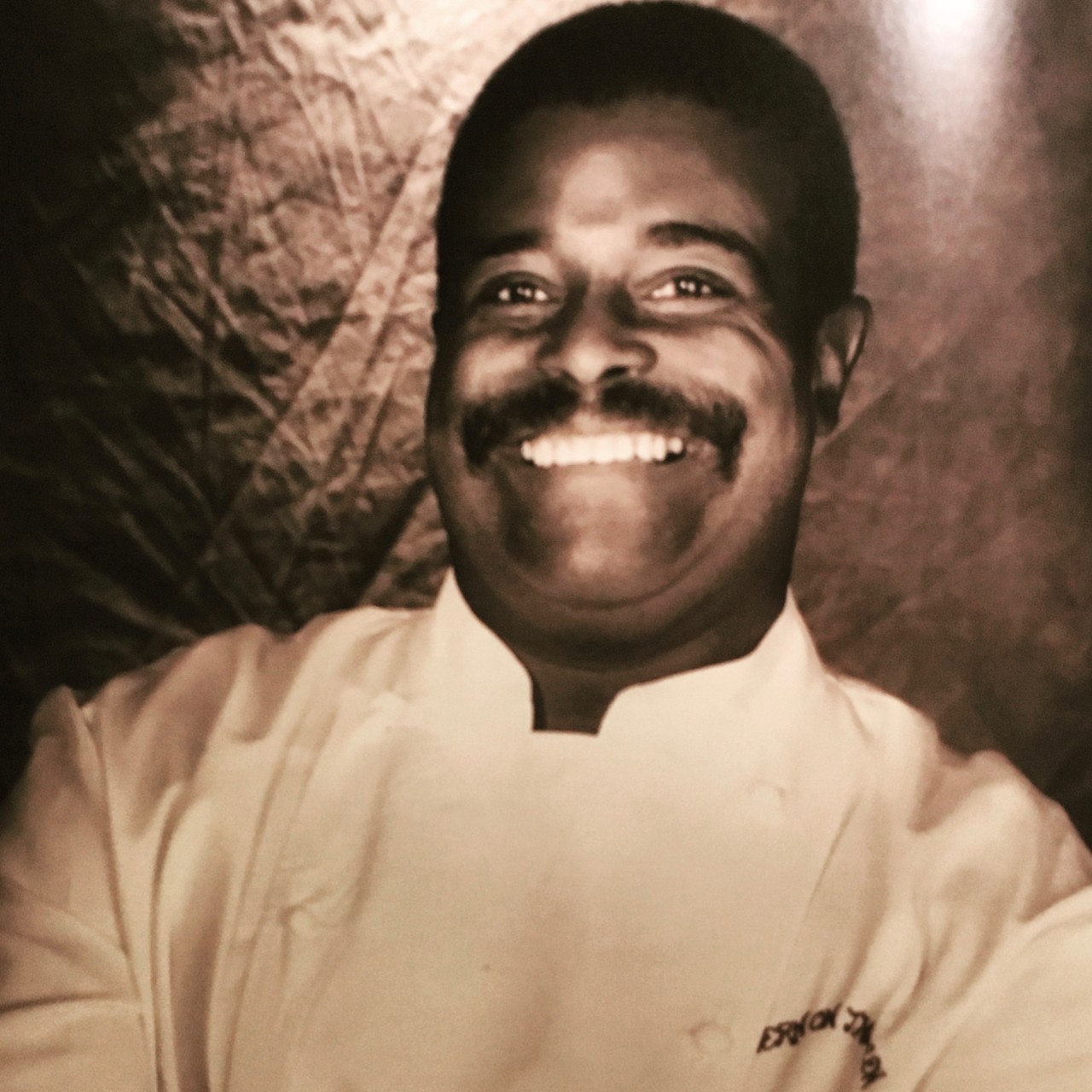
The late chef Patrick Clark …
Bathroom Break
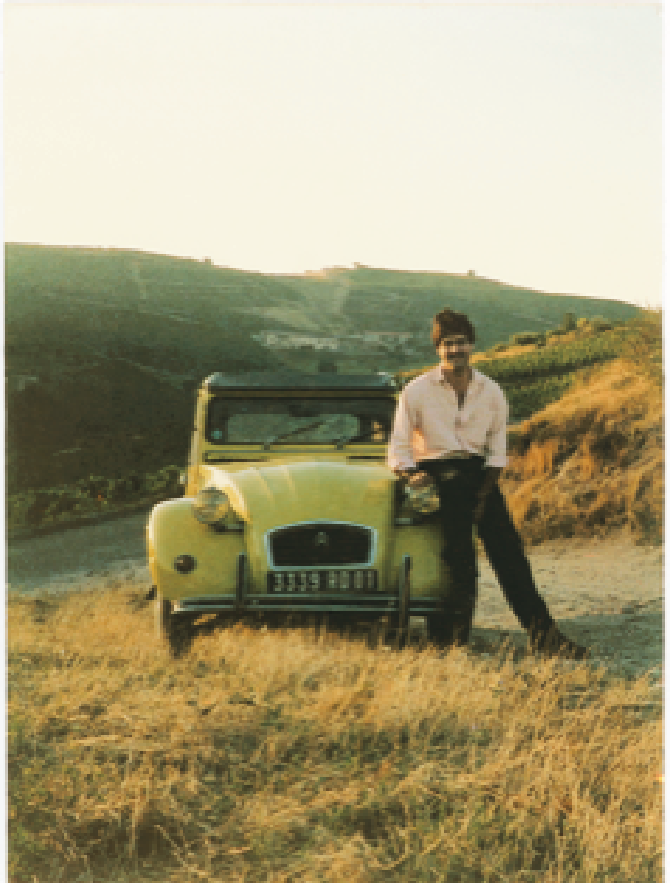
Don Pintabona, visiting the vineyards of Burgundy, during his staging days … (photo copyright Don Pintabona)
Working a stage (the Americanized shorthand for stagiaire, a kitchen position taken for no money, in exchange for knowledge), became a rite of passage for many young American cooks–mostly East Coasters–in the 1970s and 1980s. The stories I heard about these adventures, many of them punctuated by anti-Americanism, could fill a book all its own. For now, here’s a snippet of my interview with Don Pintabona, original chef of Tirbeca Grill, who went to work for Georges Blanc in Vonnas in the early 1980s:
Friedman: I’m interested in how you were perceived and received there because this comes up a lot.
Pintabona: I started in the pastry department, in which I had no experience in at all.
Friedman: And you spoke no French?
Pintabona: And I spoke no French. But the pastry chef, he spent some time in California so his English was pretty good. So the first day I’m looking for flour or whatever the hell I was looking for and he just kind of barks at me in French. And I didn’t know what the hell he meant.
Friedman: What did he say?
Pintabona: “What are you looking for?” But I didn’t know, and the way he said it, it was really kind of mean and he could see the look on my face. Anyway over time he became really friendlier. He had a pastry shop in Cannes. So he would go home every weekend; he lived weekdays in Vonnas, so it was a four or five hour drive. Then he would take me home and I’d spend weekends with him. We became really, really close. He was one of those Frenchmen that once he got a taste of America —
Friedman: — basically became American.
Pintabona: — he hated Frenchmen. And he never got along with Georges Blanc. They were always fighting and this and that. So one day he comes up to me in the kitchen and he gives me the recipe book. He goes, “I’m leaving. Here’s the book.” He goes, “I’m not telling anybody. You’re the only one I’m telling. Here’s the recipes, do what you want but when you show up to work tomorrow I’m not going to be here.” So I show up to work the next day and no Michel. The chef’s looking for him. “Where’s Michel?” They knew we were tight. I’m like, “I don’t know. I haven’t seen him yet.” George Blanc comes in the kitchen: “Where’s Michel?” So after a day or two they figure out he ain’t coming back. So they were, “Shit, this is a three-star restaurant, three star Michelin.” So there were about ten pastry cooks, all French obviously, and then this chef de hamburger on the side. So I stashed the recipe book in the employee bathroom up in the ceiling.
Friedman: You mean there were panels in the ceiling, set in a frame?
Pintabona: Exactly. I kept the recipe book up there. And then Blanc asked all the French pastry cooks, “Who knows how to make such and such?” And they’re, like, “Michel has the book. He’s got the recipe.” And I was like, “You know, I think I could make that.” And he goes, “Go ahead.” I said, I have to use the bathroom first. So I go take a piss and I write it down and I make it. And he looked and …holy shit. “Well how about this?” I said, “I can do that … I got to go to the bathroom first.” I don’t know what kind of bladder problem he thought I had but that first day I swear to God I went to the bathroom like six times; nobody knew I had the recipes. And then finally, that’s when they started taking me seriously. It was, like, “Wow, this guy really can do it.” I became kind of like the de facto pastry chef. And then once he hired a new pastry chef, he moved me to every station in the kitchen. I proved my worth. And they treated me completely different. But having the recipe book definitely helped.
Has Table 12 Finished Their Aria Yet?
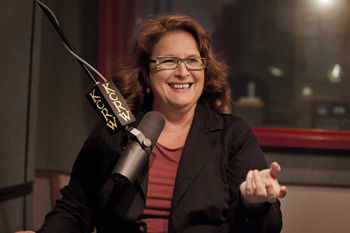
Evan Kleiman, at the helm of Good Food… (photo copyright Evan Kleiman)
As Evan Kleiman knows, she’s my radio role model; I just love her show Good Food. But Evan was also an accomplished chef in 1980s Los Angeles, and one of the city’s foremost practitioners of Italian food, at a time when authentic Italian was just gaining a foothold in the US. Evan’s present in my book more as historian than chef, so here’s a moment from our interview covering her early kitchen career, and first chef gig:
Kleiman: So I graduate, I get my degree, and I’m working for this independent producer and I’m still catering. And I realize I have to make a choice. And at that point a restaurant had opened in Los Angeles called Mangia, that was a partnership of two women who had gone to the Giuliano Bugialli School in Florence. And it was the most real Tuscan dining experience in Los Angeles. I don’t even know how I got the balls to do this, but I walked in there one day and I just said to her, “I know how to make this food. I can do it as well or better than the people you have working for you. And if you give me a chance, I’ll work for you for two weeks for free to prove myself.”
I’d worked for caterers before, private caterers. I’d never worked in a restaurant before. And the first day I was there, it was as if I put on a coat that was just made for me.
Friedman: You stayed for there how long?
Kleiman: I stayed there for a year then I got the opportunity to be the opening chef of a strange hybrid restaurant that was an opera restaurant, but I knew ‑‑
Friedman: That was a what restaurant?
Kleiman: An opera restaurant. Called Verdi. It doesn’t exist anymore.
Friedman: What is an opera restaurant?
Kleiman: Well, they had a really amazing ‑‑ they weren’t singing waiters; they were actual opera singers who would, in between service, sing. I got involved because the architect, Thom Mayne, was a friend of mine. Thom Mayne, who is a Pritzker prize winner and who is huge now. He was designing it. So I thought, you know, at that time his firm, Morphosis, was one of the up and coming deconstructionist architecture firms. And I thought, “Well, if the owner is forward-thinking enough to have them design this space?” So I became the chef there. And that was my first head chef job. And it was really challenging.
Friedman: From an organizational standpoint? From a managerial standpoint? From a ‑‑
Kleiman: Everything. First of all, I was in my mid‑twenties but I probably looked like I was fourteen. I was a woman, you know, a girl really. I was self‑taught. Everybody else in the kitchen, everybody in the front of the house, were real professionals. There was a lot of drama because the owner was a drama king. Both his children worked at the restaurant, so that was interesting.
And then there was the issue of the singing. So you’d have everything ready to go out and then it would be, “No, you can’t. You have to wait. We can’t take it out there now.” It was insane. I mean, they would make the waiters carry everything on trays around the block through a second door on the other side of the building. It was insane. But for me it was trial by fire. And I got a good review from the Los Angeles Times restaurant critic Lois Dwan. I was so brave then.
Sandy Baby
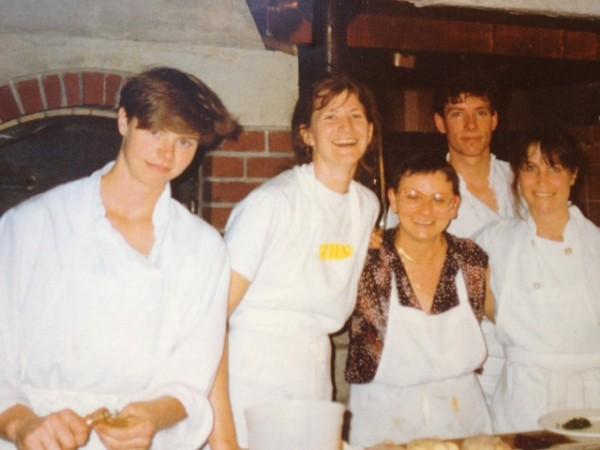
Gayle Pirie, left, in her Zuni Cafe days; to her right is Judy Rodgers and that’s John Clark next to Judy… (photo copyright Gayle Pirie)
Foreign Cinema‘s Gayle Pirie, who began life as a painter before committing to cooking, spent years in the late Judy Rodgers’s kitchen at Zuni Cafe, where she honed her craft and met future (personal and professional) partner, fellow chef John Clark. At the end of our book interview, I asked Gayle for a story that summed up the era for her. Her response:
Pirie: Well, here’s a good one. You know there’s always celebrities in San Francisco because they do their club bit or whatever. Well one lunch, three of us cooks were at Stars having a really early lunch at the bar. And Sandra Bernhard, who at the time had her one-person show.
Friedman: Without You, I’m Nothing?
Pirie: Yeah. And I was just enamored with her.
Friedman: I was, too.
Pirie: I thought Oh, my God. What an artist. You know, and I look over: “Oh, shit, it’s Sandra Bernhard.” In those days, I would just do anything. Anyway, I tried coming on to her. I winked at her and I blew her a kiss. And I was trying to be cavalier. And then she did it back to me. And I thought, Oh, my God, she did it back! I said, “I’m going to go over there and talk to her.”
I went very cavalierly up to her table. “Hi, my name is Gayle and I am a cook at Zuni. You should come there for dinner tonight after the show.” Then I said, “Can you do me a favor? Can you pretend we’re like old friends, like old flames? I’ll be working the oven, and you can come in. And the staff would just go out of their minds if they thought you and I were lovers from a long time ago. Do you think you’d be into that?” And she says, “Done, done, and done.”
Friedman: She was that cool about it?
Pirie: Oh, yeah. Totally cool. So I’m cooking chickens and she walks in through the arch. And I yell, “Sandra!” and she says, “Gayle!” And we do this embrace. And she says, “How are you; I didn’t know you worked here,” this whole thing. And the entire staff, the owners, the managers, Judy —
Friedman: Jaws dropped?
Pirie: Yeah. And then she sits down. And I can’t even think straight and I’m cooking food and I have to continue. The entire cook staff, the entire floor staff, the entire restaurant could not believe it. Because at the time, they all knew that John and I were an item. So it was just kind of this great gag. And I said no, it was all a joke, I saw her at Stars.
Friedman: You broke it right then or you waited until after?
GP: Oh, I waited several hours. So I just figured: Stars, Zuni, the Wild West, chicks, let’s pretend. And she was completely affectionate, like was I was totally affectionate. Because you know there’s this thing also, you show up at a restaurant, everyone’s trying to figure out whether you’re gay or straight or what. So to mine that was perfect.
Friedman: That’s great. Did you ever see her again?
Pirie: No.
Friedman: She broke your heart?
Pirie: No. But she was very sweet. And she actually did come back again for dinner. My paintings were up at Zuni. I had a show at Zuni. So it was very cool to say, “Hey, there’s my paintings.”
Have a good week, everybody. See you back here Friday, if not sooner!
– Andrew

